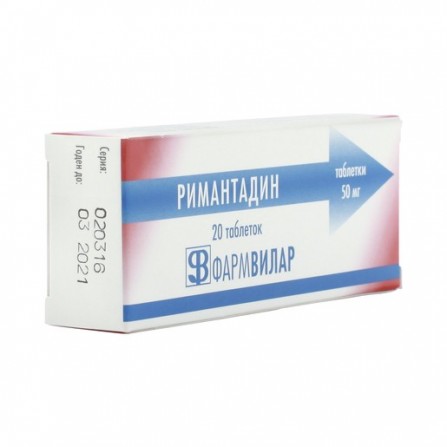Rimantadine-farmvilar pills 50mg N20
Condition: New product
1000 Items
Rating:
Be the first to write a review!

More info
Active ingredients
Rimantadine
Release form
Pills
Composition
per tablet active substances: Rimantadine hydrochloride - 50 mg; excipients: lactose (milk sugar) - 60 mg, potato starch - 37 mg, calcium stearate - 1.5 mg, talc - 1.5 mg.
Pharmacological effect
Rimantadine is active against various strains of influenza A virus. As a weak base, rimantadine acts by increasing endosomes that have a membrane of vacuoles that surround the virus particles after they enter the cell. The prevention of acidification in these vacuoles blocks the fusion of the viral envelope with the membrane of the endosome, thus preventing the transfer of viral genetic material into the cytoplasm of the cell. Rimantadine also inhibits the release of viral particles from the cell, i.e. interrupts the transcription of the viral genome.
Pharmacokinetics
After oral administration, rimantadine is almost completely absorbed in the intestine. Absorption is slow. Communication with plasma proteins is about 40%. Distribution volume: adults - 17-25 l / kg, children - 289 l. Concentration in nasal secretion is 50% higher than in plasma. The maximum concentration (C) of the active substance in the blood plasma at a dose of 100 mg once a day is 181 ng / ml, with 100 mg twice a day it is 416 ng / ml. Metabolized in the liver. The half-life is 24-36 h; 75-85% of the accepted dose is excreted by the kidneys mainly in the form of metabolites, 15% - in unchanged form. In chronic renal failure, the half-life increases 2-fold. In patients with renal insufficiency and in elderly people, it can accumulate in toxic concentrations if the dose is not adjusted in proportion to the decrease in creatinine clearance (CC).
Indications
Prevention and early treatment of influenza in adults and children over 7 years old, prevention of influenza during epidemics in adults, prevention of tick-borne encephalitis of viral etiology.
Contraindications
Acute liver diseases, acute and chronic kidney diseases, thyrotoxicosis, pregnancy, children under 7 years old, hypersensitivity to rimantadine.
Precautionary measures
Rimantadine is used with caution in cases of arterial hypertension, epilepsy (including history), and atherosclerosis of cerebral vessels.
Use during pregnancy and lactation
Contraindicated in pregnancy.
Dosage and administration
Inside after eating, drinking water. Treatment of influenza should be started within 24-48 hours after the onset of symptoms of the disease. An adult on the first day is prescribed 100 mg 3 times a day; on the second and third days, 100 mg 2 times a day; on the fourth and fifth day, 100 mg once a day. On the first day of the disease, it is possible to use the drug once at a dose of 300 mg. Children at the age of 7 to 10 years old are prescribed 50 mg 2 times a day; from 11 to 14 years - 50 mg 3 times a day. Older than 14 years - doses for adults. It is taken within 5 days. For the prevention of influenza, adults are prescribed 50 mg once a day for up to 30 days. Children over 7 years old - 50 mg once a day for up to 15 days.
Side effects
On the part of the digestive system: epigastric pain, flatulence, increased bilirubin in the blood, dry mouth, anorexia, nausea, vomiting, gastralgia. For the central nervous system: headache, insomnia, nervousness, dizziness, impaired concentration, drowsiness, anxiety, irritability, fatigue. Other: allergic reactions.
Overdose
Symptoms: arousal, hallucinations, arrhythmia. Treatment: gastric lavage, symptomatic therapy: activities to maintain vital functions. Rimantadine is partially excreted by hemodialysis.
Interaction with other drugs
With the simultaneous use of rimantadine reduces the effectiveness of anti-epileptic drugs. Adsorbents, astringents and coating agents reduce the absorption of rimantadine. Means that acidify urine (ammonium chloride, ascorbic acid), reduce the effectiveness of rimantadine (due to increased its excretion by the kidneys). sodium bicarbonate) increase its effectiveness (reduced excretion by the kidneys). Paracetamol and acetylsalicylic acid reduce Cmax of rimantadine by 11%. Cimetidine with izhaet rimantadine clearance by 18%.
special instructions
When using rimantadine may exacerbate chronic comorbidities. Elderly patients with arterial hypertension increase the risk of hemorrhagic stroke. With indications of a history of epilepsy and anticonvulsant therapy, the risk of developing an epileptic seizure increases with the use of rimantadine.In such cases, rimantadine is used in a dose of up to 100 mg / day simultaneously with anticonvulsant therapy. In case of influenza caused by the B virus, rimantadine has an antitoxic effect. time of flu epidemic. Perhaps the emergence of drug-resistant viruses.




